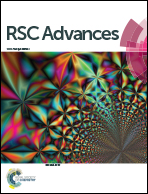Combined DFT and experimental study of the dispersion and interaction of copper species in Ni-CeO2 nanosized solid solutions†
Abstract
Nanosized nickel (Ni) and copper (Cu) doped ceria (CeO2) have attracted attention as solid solutions for energy- and environment-related applications. Furthermore they present an interesting combination of thermal and chemical stability and catalytic activity in technologically important reactions like water gas shift, ethanol reforming, hydrogenation, among others. In contrast, not much is known about the key-factors that govern the formation and the nature of the atomic structure of these materials. This study investigated with the help of the density functional theory (DFT) and experimental methodologies the formation of ceria-based solid solutions in the presence of Ni and Cu species. The materials were prepared by the incipient wetness impregnation and subsequently characterized by various experimental techniques (XPS, Raman, XRD, XRF, HR-TEM), while the electronic structures have been investigated by using DFT calculations with Hubbard corrections (DFT+U method). Theoretical calculations and experimental studies suggest that Ni species are able to form a solid solution by isomorphic substitution of bulk Ce atoms, however it was found a limit after which saturation is reached and therefore the addition of extra Ni atoms do not affect the crystal structure of the solid solution. Consequently, the formation of surface domains of nickel oxide (NiO) phases is expected. According to our findings the addition of small amounts of Cu can neither disturb the bulk structure nor force the incorporation of Cu atoms and therefore Cu species are also expected to segregated oxide (CuO). Our theoretical approach is consistent with the experimental data and we could identify an idealized solid solution structure that presents a close similarity with the experimental findings. From this theoretical structure, an interaction of the type Ni–Ni pair was identified. Our theoretical studies have predicted lattice contraction as a function of the Ni loading. From an energetic point of view we show that small amounts of Ni are easily incorporated whereas by raising Ni concentration and by adding Cu a sharp increase of the formation energy is observed. High formation energies along with strong lattice contractions was associated as plausible causes for the segregation of both Ni and Cu oxides and have been suggested as simple indicators of key factors for tailoring doped oxides containing controlled dopant concentrations.


 Please wait while we load your content...
Please wait while we load your content...